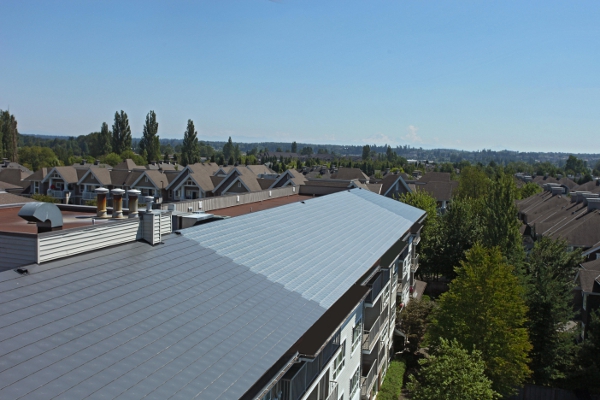A new BIPV product hopes to take the new build and re-roofing market by storm.
Building-integrated photovoltaics (BIPV) is the outcast from high school, not quite popular enough to make varsity. Everyone knows all about traditional PV installations, but they may be missing out on BIPV’s long list of advantages just because it’s not in mainstream knowledge. MSR Innovations Inc., a new player in solar roofing based in British Columbia, recently introduced its SolTrak product to the residential market and hopes to change people’s opinions of BIPV for the better.
 Getting involved with solar wasn’t even in the original plans for MSR Innovations. The founders, previously from the automotive industry, were just looking to redo one of their roofs.
Getting involved with solar wasn’t even in the original plans for MSR Innovations. The founders, previously from the automotive industry, were just looking to redo one of their roofs.
“We stared at it for ages and thought, ‘This is a medieval technology. What can we do to change this?’” says Tim Roddick, founder and CTO. “We started looking into the world of roofing, but it is such a huge industry that we needed to narrow the focus.”
The founders were also in the clean tech world, so they thought about changing the technology in roofing with a clean tech aspect, and solar was the obvious choice. BIPV narrowed the focus even more.
“We do the whole roof,” Roddick says. “We do a solar component, but the majority of our roof is non-solar. If we can get a good south-facing slope, we cram as much solar on as we can. The rest of the building envelope is non-solar tiles that are of a similar nature to the solar ones in their construction.”
The SolTrak tile connects to the roof in a “Lego-like” fashion, Roddick says. First, a long extrusion acts as a track and is connected to the roof. Tiles are then snapped into the track, locked in at each corner. The tiles consist of a backing plate, a solar cell and a polymer cover. A SolTrak system is fully integrated; it doesn’t fit into a separate roofing product or need shingles or tiles to adhere to. Requiring no tools but your hands to snap tiles into place, the MSR Innovations BIPV system is a quick installation and easily replaced or repaired.
“Our big differentiator is the design around the installation process,” Roddick says. “These days, the cost [of BIPV] is in the installation. We have designed the installation to be easier and quicker to install than previous BIPV products. We use some automotive manufacturing techniques — injection molding being the key. We lay down a long extrusion and then we snap in the tiles as we go.”
Wiring and interconnection is also a quick process.
 “Because it’s injection molding, we can do a lot of really intricate design details that you can’t do with any other form of roofing,” Roddick says. “The tile is raised up enough for the wiring to go underneath. We snap in the tile into the track and then you make the connection from connectors that are attached to the next tile, and then you snap that tile down. There is a two-step process — connect and then snap-in the tile. The wiring is hidden from view.”
“Because it’s injection molding, we can do a lot of really intricate design details that you can’t do with any other form of roofing,” Roddick says. “The tile is raised up enough for the wiring to go underneath. We snap in the tile into the track and then you make the connection from connectors that are attached to the next tile, and then you snap that tile down. There is a two-step process — connect and then snap-in the tile. The wiring is hidden from view.”
MSR Innovations has spent more than five years developing the durable, watertight SolTrak product. In September 2013, the company finished a 20-kW install at a seniors residence in British Columbia. Now with a successful project under their belts, those at MSR Innovations are targeting new builds and re-roofing projects. People want to take advantage of solar energy without being especially flashy.
“When we first got into the roofing business, we didn’t really grasp how important the aesthetics are on a roof. It’s crucial,” Roddick says. “People do want an integrated look, [but] there’s a bit of keeping up with the Joneses. They want it to fit, they want it to be aesthetically pleasing, but they do want people to see that they’re forward-looking and they have solar on their house. If you went [with a] bare-boned asphalt roof with solar slapped on top, it would be as quick as our product, [but] quite a bit uglier and not an integrated system.”
 When considering the overall cost of a new roof with traditional solar installed, BIPV can be cheaper. With a BIPV system, there are no mounting hardware or asphalt/tile installation costs.
When considering the overall cost of a new roof with traditional solar installed, BIPV can be cheaper. With a BIPV system, there are no mounting hardware or asphalt/tile installation costs.
“We’re not that much different from a typical solar panel provider other than we’re not really restricted by space,” Roddick says. “We have lots of room, so we go for dollar per watt for our solar purchase. We rarely fill the entire southern face of the roof [with solar]. If we need more solar, we yank off a non-solar tile and put on a solar one. There is lots of real estate up there.”
Roddick believes residential solar is really an untapped market.
“One of the biggest advantages of solar is generating power where you use it,” he says. “Residential sales, I think, are in their infancy. It’s an expanding market.”
If given the chance, BIPV could be a strong leader in the residential market.
— Solar Builder magazine
[source: http://solarbuildermag.com/featured/bipv-soltrak-msr-innovations/]

Leave a Reply
You must be logged in to post a comment.